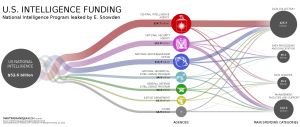The below chart is quite interesting at multiple levels.
Specific Phi Beta Iota comments are provided below the fold.

Phi Beta Iota:
01 The CIA budget appears over-stated, and the NSA budget under-stated in relation to the authorized budget. Off-budget numbers are naturally not included.
02 Covert Action and Foreign Intelligence Service Subsidies are not broken out and should be.
03 This does not include the Military Intelligence Program (MIP) and Special Oprations Black Budget, if those were included we are probably closer to $120 billion a year. The MIP contributes very significant amounts to NSA particularly, which probably triples the NSA budget and explains the charts misrepresentation of CIA as the largest budget element.
04 Data processing is actually storage, not exploitation, this is a misrepresentative label.
05 Data analysis is shown as 11% of the total, this appears severely overstated. Depending on what is counted, we believe data processing (machines making sense) and data analysis (humans making sense) to be closer to 1% of the total budget, each.
06 Management, facilities, and support is 27% of the total — over one quarter — and includes the world's most cchallenged security “system”. As Snowden has noted, NSA still has no idea what he took from where. Outreach and sharing are not part of this construct but 70% of all funds going to contractors is central to how the money is disbursed, made to disappear, without ever actually producing a full range of decision-support products and services.
07 Now imagine an Open Source Agency that limits permanent personnel, internal IT, and facilities costs to a total of 20%, and spends the other 80% on integrated open source data acquisition and near-real-time analysis by multinational, multiagency, multidisciplinary, multidomain subject matter experts and locationally-grounded observers who produce decision-support — tailored answers to specific questions from across the spectrum of consumers at the strategic, policy, acquisition, and operations levels. At $2 billion a year ($10 million a year for each of 200 countries, targets, and topics not now covered by the secret intelligence budget shown above), that would seem to be a bargain for the taxpayer.



